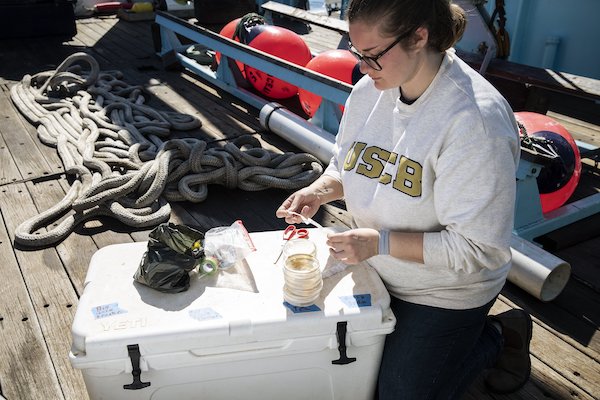Two USCB Students Join OCEARCH Expedition for Shark Research
 Tori Sember plates bacteria collected from a shark. Photo credit: Chris Ross/OCEARCH
Tori Sember plates bacteria collected from a shark. Photo credit: Chris Ross/OCEARCHRough seas, high winds and driving rain didn’t dampen the enthusiasm of University
of South Carolina Beaufort students William Crowson and Tori Sember, who last month
joined an OCEARCH research expedition in search of white sharks.
The Biology students were guest researchers on OCEARCH's 43rd Expedition in the western North Atlantic. OCEARCH tags and tracks sharks, whales, turtles and other marine life and publishes a real-time tracker on its website to follow the tagged sea creatures. Its staff scientists and master fishermen have tagged 84 white sharks to collect data about their health, reproductive behavior, and migratory patterns. Data and findings collected by OCEARCH are open-sourced and often used by public safety programs and in medical research for shark bite victims. Invited scientists from many academic institutions also pursue their own research questions when they join OCEARCH expeditions.
Crowson and Sember are seniors and students of USCB’s Dr. Kim Ritchie, who is investigating properties of beneficial bacteria on the skin of sharks. During their March 4-24 expedition in waters off North Carolina, South Carolina Georgia and Florida, the students enjoyed collaboration and camaraderie with other scientists.
“We got to work with the best of the best,” Crowson said.
Because bad weather forced the boat to change its planned course and to stay in port several days, the students felt lucky that the group caught one white shark during the trip. The OCEARCH boat is a 126-foot former crabbing vessel outfitted with a lift that raised the shark to the level of the boat’s deck, where Crowson swabbed it in seven different places. He described OCEARCH’s protocols for removing a shark from the water with the lift, recording data and taking samples, and then releasing the animal. The OCEARCH team kept the shark comfortable by running sea water over its gills, covering its heads with towels soaked in ocean water and getting it back in the ocean quickly.
“It was out of the water for 15 minutes max, and then it swam away,” he said.
Sember plated the samples in petri dishes and tracked the growth of bacteria colonies for the rest of time at sea.
Ritchie will use her students’ samples and analysis in a study about beneficial bacteria on the skin of sharks, rays and skates and their potential as a source for new antibiotics. The study is funded by the Port Royal Sound Foundation and other sources.
“Sharks heal their wounds very quickly and almost never get skin infections,” Sember said. “The rising resistance to current antibiotics means we’re very interested in possible applications for new antibiotics for humans.”
Learn more about the OCEARCH expedition: https://www.ocearch.org/expeditions/2022-expedition-carolinas/
Track the tagged sharks: https://www.ocearch.org/?list